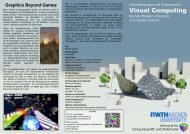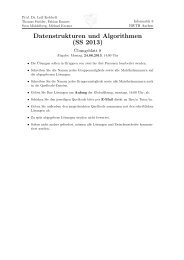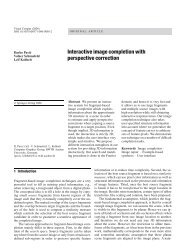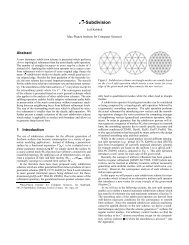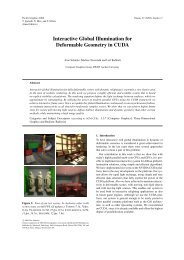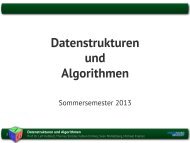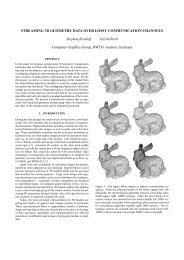Structure Preserving CAD Model Repair - OpenFlipper
Structure Preserving CAD Model Repair - OpenFlipper
Structure Preserving CAD Model Repair - OpenFlipper
You also want an ePaper? Increase the reach of your titles
YUMPU automatically turns print PDFs into web optimized ePapers that Google loves.
Stephan Bischoff & Leif Kobbelt / <strong>Structure</strong> <strong>Preserving</strong> <strong>CAD</strong> <strong>Model</strong> <strong>Repair</strong><br />
1. Conversion of M 0 to a closed mesh M (Section 3.1)<br />
2. Identification of a set C ⊂ Z 3 of critical vertices that<br />
encloses all intersections and all gaps of diameter ≤ γ 0<br />
(Section 3.2)<br />
3. Eroding C to a minimal set C ′ (Section 3.3)<br />
4. Transforming C ′ to a set D of critical cells that covers all<br />
gaps and all intersections (Section 3.4)<br />
5. Clipping M against D (Section 3.4)<br />
6. Reconstruction of the model geometry inside D (Section<br />
3.5)<br />
7. Postprocessing to reduce the output complexity (Section<br />
3.6)<br />
1. input patches 2. critical vertices<br />
3.1. Setup<br />
In the following we assume without loss of generality that<br />
the input model is scaled and translated such that the error<br />
tolerance ε 0 = 1 and that M 0 is enclosed by an integer grid<br />
of extent<br />
[0,2 k ] × [0,2 k ] × [0,2 k ]<br />
for some k. Note that the size of the grid cells just equals the<br />
error tolerance ε 0 . We also assume that the maximum gap<br />
diameter is given as γ 0 = 2γ for some positive integer γ.<br />
We often have to associate data with a small subset of<br />
the grid vertices or the grid cells. To improve memory efficiency,<br />
this data is stored in the finest-level nodes of an octree<br />
of depth k. The octree is adaptively refined on demand,<br />
i.e. when we access a certain grid vertex or grid cell.<br />
For each patch P i ∈ M 0 we produce<br />
a mirror patch P ′ i by duplicating P i and<br />
reversing the orientation of each triangle.<br />
Then we seam P i and P ′ i along their<br />
common boundary by triangle strips S i .<br />
This yields a new and closed patch Q i<br />
that represents P i from both sides. We<br />
collect the new patches in a new model<br />
M = {Q i }. Note that M is closed, but still contains the<br />
same artifacts as M 0 . Note also that by this construction our<br />
algorithm becomes invariant with respect to the orientation<br />
of the input patches. If it turns out that the resulting “double<br />
walls” are not necessary to guarantee manifoldness of the<br />
reconstruction, they will be removed in the post-processing<br />
stage, see Section 3.6.<br />
3.2. Critical regions<br />
In the following we compute a set C γ of critical grid vertices.<br />
We think of these critical vertices as particles that fill<br />
those regions of space where two or more patches of M get<br />
closer than 2γ. These critical regions include all gaps of diameter<br />
≤ 2γ and in particular all intersections between different<br />
patches. Later stages of the algorithm will then extract<br />
the interface between critical vertices and non-critical<br />
3. critical cells 4. clipped<br />
5. prelim. reconstruction 6. result<br />
Figure 2: Stages of our algorithm. The input patches typically<br />
exhibit artifacts like gaps and intersections (1). We<br />
determine a (rather large) set of critical vertices in a local<br />
neighborhood around these artifacts (2) and then convert<br />
these vertices into a (smaller) set of critical cells (3). The input<br />
patches are clipped against the critical cells (4) and the<br />
interior of the cells is reconstructed using a variant of the<br />
Marching Cubes algorithm (5). This preliminary reconstruction<br />
is then simplified to get the final result (6). Note that the<br />
model geometry away from the artifacts is not affected by<br />
our reconstruction algorithm and hence any structure in the<br />
input patches is well preserved.<br />
vertices to create surface patches that actually close the gaps<br />
and resolve the intersections.<br />
Let us call a grid vertex v ∈ Z 3 ambiguous if<br />
Box γ(v) := {w ∈ Z 3 : ||w − v|| ∞ ≤ γ}<br />
is intersected by two or more patches of M. If v is an ambiguous<br />
vertex, we set all vertices ∈ Box γ(v) to critical, i.e.<br />
C γ :=<br />
[<br />
v ambiguous<br />
Box γ(v)<br />
Figure 3 shows some configurations of M and the corresponding<br />
ambiguous and critical vertices.<br />
Ambiguous vertices can efficiently be located by using<br />
a (temporary) octree of depth k. We shift the origin of the<br />
octree by (.5,.5,.5) T such that the centers of the finest-level<br />
c○ The Eurographics Association and Blackwell Publishing 2005.




